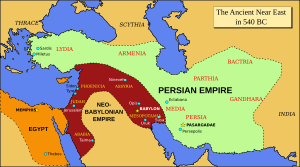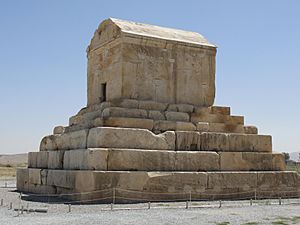Cyrus the Great facts for kids
Quick facts for kids Cyrus the Great𐎤𐎢𐎽𐎢𐏁 |
|
|---|---|
|
|

Cyrus the Great with a Hemhem crown, from a relief in the residence of Cyrus in Pasargadae
|
|
| King of Kings of the Achaemenid Empire | |
| Reign | 559–530 BC |
| Predecessor | Empire established |
| Successor | Cambyses II |
| King of Persia | |
| Reign | 559–530 BC |
| Predecessor | Cambyses I |
| Successor | Cambyses II |
| King of Media | |
| Reign | 549–530 BC |
| Predecessor | Astyages |
| Successor | Cambyses II |
| King of Lydia | |
| Reign | 547–530 BC |
| Predecessor | Croesus |
| Successor | Cambyses II |
| King of Babylon | |
| Reign | 539–530 BC |
| Predecessor | Nabonidus |
| Successor | Cambyses II |
| Born | c. 600 BC Anshan, Persis (present-day Fars Province, Iran) |
| Died | 4 December 530 BC (aged 70) Syr Darya, Central Asia |
| Burial | Pasargadae |
| Consort | Cassandane, Amytis of Media |
| Issue |
|
| House | Teispid |
| Father | Cambyses I |
| Mother | Mandane of Media |
Cyrus II of Persia (around 600–530 BC), often called Cyrus the Great, was the amazing founder of the Achaemenid Empire. This was the first great Persian empire. Under his leadership, his empire grew to include all the major civilizations of the ancient Near East. It expanded hugely, taking over most of Western Asia and a lot of Central Asia.
Cyrus's empire stretched from the Mediterranean Sea in the west to the Indus River in the east. It was the biggest empire the world had ever seen at that time. Later, under his successors, it even reached parts of Europe, like the Balkans.
Cyrus ruled for about 30 years. He built his empire by conquering the Median Empire, then the Lydian Empire, and finally the Neo-Babylonian Empire. He also led trips into Central Asia, bringing many nations under his control. Cyrus did not conquer Egypt. He is thought to have died in battle against the Massagetae, a group of nomadic tribes, in December 530 BC. However, some ancient writers say he died peacefully in his capital. His son, Cambyses II, took over and later conquered Egypt.
The Greeks called him Cyrus the Elder. He was famous for respecting the customs and religions of the lands he conquered. He created a strong central government in Pasargadae. This government ruled through local governors called satraps. This system worked very well for both the rulers and the people.
Cyrus also played a big role in Judaism. He allowed the Israelites to return to the Land of Israel after he conquered the Neo-Babylonian Empire. This event, known as the Babylonian captivity, is described in the Bible. The Bible even calls him a messiah (meaning "anointed one"). Cyrus is the only non-Jewish person in the Bible to be called this.
Cyrus is also remembered for his achievements in human rights, politics, and military strategy. His influence spread across both Eastern and Western civilizations. Even in Athens, rich Athenians copied parts of Persian culture. Cyrus, who came from Persis (modern-day Fars Province in Iran), helped shape Iran's national identity. He is still a hero to many Iranians, and his tomb is a respected place. In the 1970s, the last Shah of Iran, Mohammad Reza Pahlavi, said that the Cyrus Cylinder was the oldest human rights declaration. Some historians disagree, saying it was a common statement for new kings.
Contents
Who Was Cyrus the Great?
Cyrus's Early Life and Family History
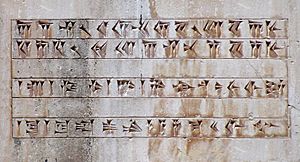
Cyrus was born around 600-599 BC. His father was Cambyses I, the King of Anshan. His mother was Mandane, the daughter of Astyages, the King of Media.
Cyrus said that his father Cambyses I, grandfather Cyrus I, and great-grandfather Teispes were kings before him. This is generally believed to be true. Cyrus married Cassandane, who was also from the Achaemenid family. They had two sons, Cambyses II and Bardiya, and three daughters, Atossa, Artystone, and Roxane.
Cyrus and Cassandane loved each other deeply. When Cassandane died, Cyrus ordered public mourning throughout his kingdom. The Nabonidus Chronicle says that Babylonia mourned her for six days. After his father's death, Cyrus became the Persian king in Pasargadae. At that time, Pasargadae was under the control of Astyages.
How Cyrus Built His Empire
Conquering the Median Empire
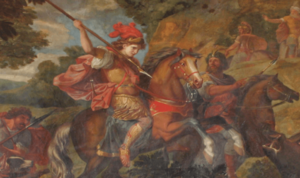
Cyrus the Great became king in 559 BC after his father died. However, he was not yet fully independent. He still had to recognize the Median king, Astyages, as his overlord. Astyages, who was also Cyrus's grandfather, likely ruled most of the Ancient Near East.
According to ancient records, Astyages attacked Cyrus. Astyages put his general, Harpagus, in charge of the Median army. But Harpagus secretly contacted Cyrus and encouraged him to rebel. Harpagus and many other nobles then switched sides and joined Cyrus.
This rebellion is confirmed by the Nabonidus Chronicle. The fighting lasted about three years (553–550 BC). The final battle led to Cyrus capturing Ecbatana, the Median capital. Cyrus spared Astyages' life and married his daughter, Amytis. This marriage helped bring peace with other groups like the Bactrians and Parthians. Cyrus also brought Sogdia into his empire.
With Astyages defeated, all his former subjects came under Cyrus's rule. Cyrus's uncle, Arsames, who was king of Parsa, gave up his throne. This change of power within the family was smooth. Arsames likely remained a local governor under Cyrus. Cyrus the Great then united the two Achaemenid kingdoms of Parsa and Anshan into what became Persia. Cyrus's conquest of Media was just the beginning of his many wars.
Taking Over the Lydian Empire
We don't know the exact dates of the Lydian conquest. It happened between Cyrus's defeat of Media (550 BC) and his conquest of Babylon (539 BC). The Lydians, led by their king Croesus, first attacked the Persian city of Pteria. Croesus captured the city and enslaved its people.
The Persians then asked the people of Ionia, who were part of the Lydian kingdom, to rebel. They refused. So, Cyrus gathered an army and marched against the Lydians. The first major fight, the Battle of Pteria, was a draw. Both sides lost many soldiers. Croesus then went back to his capital, Sardis.
Croesus asked his allies for help. But before they could arrive, Cyrus attacked Lydian territory. He surrounded Croesus in Sardis. Before the final battle, the Battle of Thymbra, Cyrus used a clever trick. His general, Harpagus, told him to put his camels in front of his soldiers. Lydian horses were scared of the camels' smell. This worked, and the Lydian cavalry ran away.
Cyrus defeated and captured Croesus. He took over Sardis, conquering the Lydian kingdom in 546 BC. Some stories say Cyrus spared Croesus and kept him as an advisor. Other records suggest Croesus was killed.
After the conquest, a Lydian named Pactyas was supposed to send Croesus's treasure to Persia. But Pactyas hired soldiers and started a rebellion in Sardis. Cyrus sent his commander, Mazares, to stop the uprising. Mazares captured cities like Magnesia and Priene. Mazares died during his campaigns in Ionia. Cyrus then sent Harpagus to finish the conquest of Asia Minor. Harpagus captured Lycia, Cilicia, and Phoenicia. He used new methods, like building earthworks, to break through city walls. He finished his conquest in 542 BC.
Campaigns in the East
After conquering Lydia, Cyrus campaigned in the eastern regions from about 545 BC to 540 BC. He first tried to conquer Gedrosia, but his army was defeated. Later, Gedrosia came under the rule of Darius I.
Cyrus then attacked areas like Bactria, Archosia, Sogdia, Saka, Chorasmia, and Margiana. In 533 BC, Cyrus the Great crossed the Hindu Kush mountains. He collected tribute from cities in the Indus Valley. This means he likely had control over parts of India. After these campaigns, Cyrus returned near Babylon because of unrest there.
Conquering the Neo-Babylonian Empire
By 540 BC, Cyrus captured Elam and its capital, Susa. Ancient records show that the Babylonian king, Nabonidus, brought religious statues into his capital. This suggests that a conflict was about to begin. In October 539 BC, Cyrus fought the Battle of Opis near the city of Opis on the Tigris River. The Babylonian army was completely defeated.
A few days later, on October 10, Sippar was captured without a fight. It's possible Cyrus negotiated with Babylonian generals to avoid more fighting. Nabonidus, who had fled to Sippar, then went to Borsippa.
On October 12, Cyrus's troops entered Babylon without resistance. They captured Nabonidus. The Greek historian Herodotus said the Persians diverted the Euphrates river. This made the water level drop, allowing them to march through the riverbed at night. On October 29, Cyrus himself entered Babylon.
Before Cyrus's invasion, the Neo-Babylonian Empire had conquered many kingdoms. After taking Babylon, Cyrus likely added these areas, like Syria and Judea, to his empire.
After taking Babylon, Cyrus the Great called himself "king of Babylon, king of Sumer and Akkad, king of the four corners of the world." He wrote this on the famous Cyrus Cylinder. This cylinder was placed in the foundations of the Esagila temple, dedicated to the Babylonian god Marduk. The cylinder says that Cyrus improved the lives of Babylonians. It also says he sent displaced people home and restored temples. Some people say the cylinder is an early human rights document. However, historians usually see it as a traditional statement new kings made when they began their rule.
By the end of Cyrus's rule, the Achaemenid Empire was the largest the world had ever seen. It stretched from Asia Minor in the west to the Indus River in the east.
How Did Cyrus the Great Die?
The stories about Cyrus's death are different. One account by Herodotus says Cyrus died in a fierce battle. He was fighting the Massagetae, a group of Iranian tribes from Central Asia. This happened after he tried to attack them in their own land. The Massagetae were similar to the Scythians and fought on horseback. Cyrus had first offered to marry their queen, Tomyris, but she refused.
Another writer, Ctesias, says Cyrus died while fighting the Derbices infantry, who were helped by other Scythian archers and Indian war elephants. This happened northeast of the Syr Darya river. However, Xenophon wrote that Cyrus died peacefully in his capital. A final account from Berossus simply says Cyrus died fighting the Dahae archers northwest of the Syr Darya.
Cyrus's Burial Place
Cyrus the Great's body is believed to be buried in his capital city of Pasargadae. A limestone tomb, built around 540–530 BC, still stands there today. Many believe it is his. According to Plutarch, the words on his tomb said:
O man, whoever you are and wherever you come from, for I know you will come, I am Cyrus who won the Persians their empire. Do not therefore begrudge me this bit of earth that covers my bones.
Ancient Roman and Greek writings describe the tomb in detail. It has a large square stone base, with smaller rectangular stones stacked on top like a pyramid. At the very top is a small building with an arched roof and a small opening.
Inside this building was a golden coffin on a golden table, holding Cyrus the Great's body. The coffin was covered with beautiful tapestries and drapes. A red carpet lay below it. The tomb was in the fertile gardens of Pasargadae, surrounded by trees. A group of Achaemenian guards called the "Magi" protected it.
Years later, when Alexander the Great invaded Persia, Cyrus's tomb was broken into and robbed. When Alexander saw the tomb, he was very upset. He questioned the Magi and put them on trial. Some say Alexander did this to show his power in his new empire. But Alexander also admired Cyrus. He had read about Cyrus's heroism and leadership in a book called Cyropaedia. Alexander ordered Aristobulus to fix the tomb and restore its inside.
The tomb has survived many centuries, invasions, and changes in power. The last Shah of Iran, Mohammad Reza Pahlavi, also drew attention to the tomb. He used Cyrus's legacy to strengthen his own rule during the celebrations of 2,500 years of monarchy. The United Nations recognizes the tomb of Cyrus the Great and Pasargadae as a UNESCO World Heritage Site.
Cyrus's Lasting Legacy
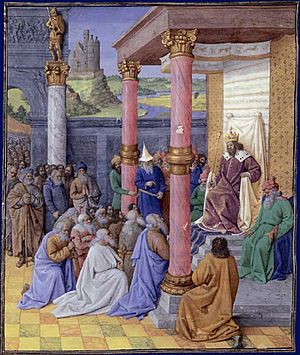
The British historian Charles Freeman said that Cyrus's achievements were far greater than those of Alexander the Great. Alexander destroyed the Achaemenid Empire but couldn't create a stable replacement. Cyrus has been a hero to many important people, including Thomas Jefferson and David Ben-Gurion.
Cyrus the Great is remembered for his achievements even today. His own people, the Iranians, called him "The Father." This was the same title used by many nations he conquered, as recorded by Xenophon:
And those who were subject to him, he treated with esteem and regard, as if they were his own children, while his subjects themselves respected Cyrus as their "Father" ... What other man but 'Cyrus', after having overturned an empire, ever died with the title of "The Father" from the people whom he had brought under his power? For it is plain fact that this is a name for one that bestows, rather than for one that takes away!
The Babylonians called him "The Liberator."
The Book of Ezra in the Bible tells how Cyrus allowed the Jewish exiles to return home. Cyrus declared: "All the kingdoms of the earth hath the LORD, the God of heaven, given me; and He hath charged me to build Him a house in Jerusalem, which is in Judah."(Ezra 1:2)
Cyrus was a skilled statesman and soldier. The strong government he created helped the Achaemenid Empire last long after his death.
Persia's rise under Cyrus had a huge impact on world history. Iranian philosophy, literature, and religion were very important for the next thousand years. Even after the Islamic conquest in the 7th century AD, Persia continued to influence the Middle East. It played a big part in the growth of Islam.
Many later Iranian dynasties saw themselves as continuing Cyrus the Great's legacy. Alexander the Great himself admired Cyrus. He read about Cyrus's bravery and leadership in the Cyropaedia. When Alexander visited Pasargadae, he ordered Cyrus's tomb to be restored.
Cyrus's influence reached far, even to Iceland and colonial America. Many thinkers and leaders from Classical Antiquity, the Renaissance, and the Enlightenment were inspired by Cyrus. For example, Thomas Jefferson, one of the founding fathers of the United States, owned copies of Cyropaedia. This book greatly influenced his ideas for the United States Declaration of Independence.
Professor Richard Nelson Frye says Cyrus's skills as a conqueror and ruler are shown by how long and strong the Achaemenid Empire was. Frye writes that Cyrus became a legendary figure among Persians, like Romulus and Remus in Rome or Moses for the Israelites. He was seen as the perfect ruler: tolerant, generous, brave, and daring. His personality influenced the Greeks and Alexander the Great. This influence, passed down by the Romans, may still affect our thinking today.
Cyrus's Views on Religion and People
It is believed that the teachings of Zarathushtra influenced Cyrus's actions. However, there is no clear proof that Cyrus followed a specific religion. Historians say it's hard to know exactly what Cyrus's religion was.
Cyrus's policies on how he treated different religions are recorded in Babylonian and Jewish texts. He had a general policy of religious tolerance throughout his vast empire. He brought peace to the Babylonians. He is said to have kept his army away from temples and returned statues of Babylonian gods to their shrines.
His treatment of the Jews during their exile in Babylon is described in the Bible. The Second Chronicles ends with Cyrus's decree. This decree allowed the exiles to return to the Promised Land from Babylon. It also gave them permission to rebuild their temple.
Thus saith Cyrus, king of Persia: All the kingdoms of the earth hath the LORD, the God of heaven given me; and He hath charged me to build Him a house in Jerusalem, which is in Judah. Whosoever there is among you of all His people – the LORD, his God, be with him – let him go there. — (2 Chronicles 36:23)
This decree is also found in the Book of Ezra.
In the first year of King Cyrus, Cyrus the king issued a decree: "Concerning the house of God at Jerusalem, let the temple, the place where sacrifices are offered, be rebuilt and let its foundations be retained, its height being 60 cubits and its width 60 cubits; with three layers of huge stones and one layer of timbers. And let the cost be paid from the royal treasury. Also let the gold and silver utensils of the house of God, which Nebuchadnezzar took from the temple in Jerusalem and brought to Babylon, be returned and brought to their places in the temple in Jerusalem; and you shall put them in the house of God." — (Ezra 6:3–5)
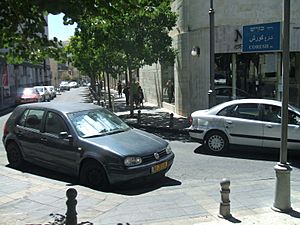
The Jews respected him as a fair and good king. In one Biblical passage, Isaiah calls him Messiah (meaning "His anointed one") (Isaiah 45:1). This makes him the only non-gentile to be called this. Elsewhere in Isaiah, God is described as saying, "I will raise up Cyrus in my righteousness: I will make all his ways straight. He will rebuild my city and set my exiles free, but not for a price or reward, says God Almighty." (Isaiah 45:13) As the text suggests, Cyrus did free the nation of Israel from exile without asking for payment.
Josephus, a Jewish historian from the first century, shares the traditional Jewish view of Cyrus. He wrote that God stirred Cyrus's heart to allow the Jews to return to their homeland and rebuild their temple. Josephus says Cyrus read the prophecies of Isaiah, which mentioned his name and his task to build God's house in Jerusalem. Cyrus was amazed by this and wanted to fulfill what was written. He called the most important Jews in Babylon and gave them permission to return. He also promised to help them with gold, silver, and animals for sacrifices.
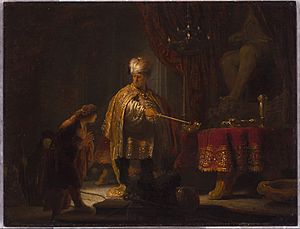
While Cyrus was praised in the Tanakh, there was some Jewish criticism later. This happened after he was tricked by the Cuthites, who wanted to stop the building of the Second Temple. They accused the Jews of planning a rebellion. So, Cyrus stopped the construction. The temple was not finished until 515 BC, during the reign of Darius I. According to the Bible, it was King Artaxerxes who was convinced to stop the temple's construction in Jerusalem (Ezra 4:7–24).
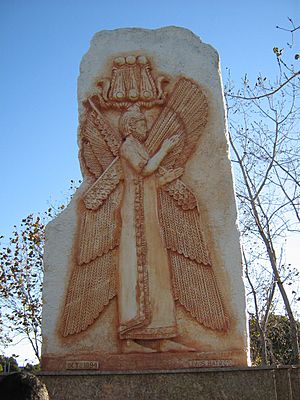
Some historians question if this decree was truly written by Cyrus. Professor Lester L. Grabbe argues that there was no specific decree. Instead, he suggests it was a general policy that allowed exiles to return home and rebuild their temples. He also says that archaeological findings suggest the return was a slow process, with perhaps only 30,000 people returning over decades.
Mary Joan Winn Leith believes the decree in Ezra might be real. She thinks Cyrus, like other rulers, used such decrees to gain support from important groups, especially those near Egypt, which he wanted to conquer. She also wrote that Cyrus's appeals to Marduk (in the cylinder) and to Yahweh (in the biblical decree) show how Persians tried to use local religious traditions to control their empire.
Some modern Muslims have suggested that the Quranic figure of Dhu al-Qarnayn might be Cyrus the Great. However, most scholars agree that this figure is based on legends about Alexander the Great.
See also
 In Spanish: Ciro II el Grande para niños
In Spanish: Ciro II el Grande para niños



